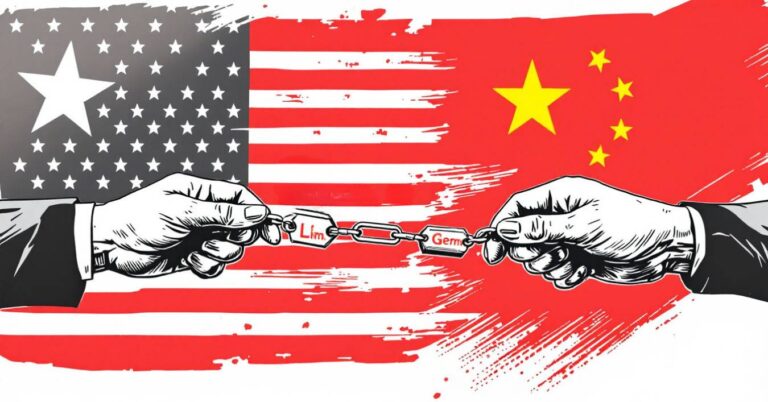China bans rare mineral exports to the US, including gallium, germanium, and antimony, in a significant escalation of the US-China tech trade war. These minerals are vital for semiconductors, military technologies, and EV batteries, exposing the US’s dependency on Chinese supply chains.
The ban follows US restrictions announced a day earlier. The move underscores China’s dominant position in global mineral processing and raises the stakes for industries reliant on advanced technologies, from AI to renewable energy.

China Bans Rare Mineral Exports to the US – Key Points
China’s Export Ban: The Details
- Latest Chinese Export Ban:
- China bans rare mineral exports to the US. Banned minerals are used in semiconductors, including gallium, germanium, and antimony.
- This follows earlier export restrictions on graphite and lab-grown diamonds.
- Exporters must now disclose the identities of end-users, a move aimed at tracking connections to US firms.
- Minerals Restricted: Gallium, germanium, antimony, tungsten, and graphite.
- Gallium: Used in high-end semiconductors, solar panels, and radar systems.
- Germanium: Essential for fiber optics, thermal imaging, and satellites.
- Antimony and Tungsten: Critical for ammunition, military equipment, and industrial applications.
- Graphite: A core component in EV batteries, with tighter export monitoring announced.
- Timing:
- The ban follows US restrictions announced a day earlier: On Monday, the US expanded its export restrictions on chip-making equipment and materials essential for high-end AI applications.The sanctions added 140 Chinese or Chinese-owned companies to the “entity list,” blocking their access to US technology. Affected entities include Piotech and SiCarrier, both with ties to the Chinese tech giant Huawei.
- It is also positioned just weeks before Donald Trump’s second presidential term, where significant tariffs on Chinese goods are anticipated.
- National Security Justifications:
- Both nations cite national security concerns, with the US seeking to curb China’s development of advanced chips for military use and China countering to protect its supply chains and economic sovereignty.
China’s Dominance in Rare Minerals
- Production and Processing:
- China produces 60% of the world’s rare minerals and processes 85% of them.
- The US relies on China for over half of its germanium and 20% of its gallium, neither of which has been mined domestically for decades.
- In 2023, China produced 98% of global gallium and dominated the market for antimony and germanium.
- Economic Leverage:
- Earlier Chinese restrictions on gallium and germanium caused prices to spike globally, with antimony reaching over $25,000 per tonne in 2024.
- The US Geological Survey estimates a $3.4 billion GDP loss for the US in the event of a total Chinese ban on gallium and germanium.
US Semiconductor and Defense Industries at Risk
- Semiconductor Dependency:
- Gallium-based semiconductors are vital for AI systems, missile defense, radar technology, and advanced electronics.
- The US has limited domestic production capacity for these materials, exacerbating reliance on Chinese exports.
- EV and Clean Energy Disruption:
- Graphite’s restriction threatens electric vehicle (EV) production, a cornerstone of US clean energy goals.
- Solar panel manufacturing could face delays due to shortages of gallium and germanium.
- Defense Industry Impact:
- Tungsten and antimony are crucial for manufacturing bullets, artillery, and other military hardware.
US Countermeasures and Challenges
- New Export Controls:
- US restrictions prohibit sales of advanced chips and manufacturing tools to China, effective December 31, 2024.
- Rules extend to foreign companies using US technology, targeting global supply chains.
- Allied Collaboration:
- Japan and the Netherlands have agreed in principle to impose similar restrictions but have yet to announce concrete actions.
- The delay has allowed China to stockpile advanced equipment.
- Domestic Investments:
- Efforts are underway to increase US mineral production, including gallium extraction as a byproduct of bauxite mining.
- Recent gallium deposits discovered in Montana could reduce dependency, though large-scale production remains years away.
China’s Broader Strategy
- Self-Sufficiency Goals:
- Beijing is aggressively investing in domestic technology supply chains to reduce reliance on US imports.
- Four major Chinese industry associations have urged members to limit their purchases of US-made chips, citing security risks.
- Global Influence:
- The move signals China’s readiness to leverage its mineral dominance in geopolitical disputes, pressuring nations to reconsider their dependence on US-led supply chains.
- Retaliatory Actions:
- Beijing is expected to target US technology firms operating in China, as it did with Micron during previous disputes.
- China’s new export-control laws and its “unreliable entity list” further bolster its ability to retaliate.
Global Economic and Geopolitical Implications
- Rising Prices and Supply Chain Fragility:
- The restrictions are likely to raise costs across industries, from consumer electronics to renewable energy.
- Companies reliant on semiconductors and rare minerals face intensified pressures to diversify suppliers.
- Splitting Global Tech Spheres:
- The tech war is increasingly bifurcating the world into US and China-aligned spheres, complicating global trade and innovation.
- Companies caught in the middle must navigate conflicting regulations and supply chain challenges.
Why This Matters:
China bans rare mineral exports to the US, opening a new front in the tech trade war. The escalating US-China trade war over critical technologies highlights vulnerabilities in global supply chains and intensifies competition for technological dominance. The disruption of rare mineral supplies threatens industries essential to national security, clean energy, and innovation. This conflict underscores the urgent need for diversified sourcing, global collaboration, and long-term strategies to mitigate geopolitical risks.
Explore the vital role of AI chips in driving the AI revolution, from semiconductors to processors: key players, market dynamics, and future implications.
Read a comprehensive monthly roundup of the latest AI news!







